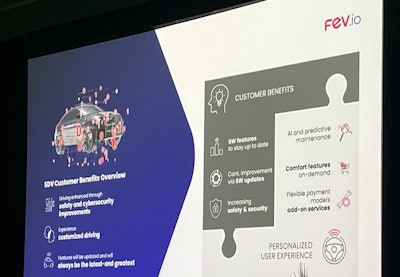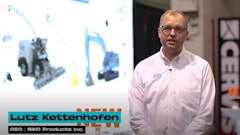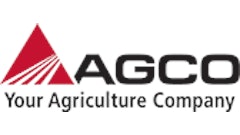
Software-defined vehicles (SDVs) has a physical meaning and is also considered conceptual, but the basic fundamental is the vehicle features and enhancements are enabled through software rather than hardware. This is not a new concept — think of the smartphone, for example — but it is a relatively new idea for vehicles in commercial and other spaces.
Julia Garcia-Trombley, manager, product strategy at FEV North America, said companies are developing a strategic approach to reduce costs and software enhancements are one way they’re doing it in her presentation “Emerging Technology: Understanding Software-Defined Vehicles” at Work Truck Week in Indianapolis during the Green Truck Summit on Tuesday.
 Julia Garcia-Trombley, manager, product strategy at FEV North America, highlighted software-defined vehicles (SDVs) in her presentation at Work Truck Week during the Green Truck Summit.Chris Vavra
Julia Garcia-Trombley, manager, product strategy at FEV North America, highlighted software-defined vehicles (SDVs) in her presentation at Work Truck Week during the Green Truck Summit.Chris Vavra
The strategic targets for an SDV are three-fold:
- Protect future business through securing revenue streams reducing costs.
- Ensure product attractiveness through adoption while acknowledging changed customer requirements.
- Transform toward an efficient and competitive software-centric organization.
Benefits for the driver include enhanced safety and cybersecurity improvements, better customized driving and having updated features that ensure the vehicle will always be up to date with the OS.
The personalized user experience also utilizes artificial intelligence (AI) and predictive maintenance to ensure downtime is minimized.
This is happening, Garcia-Trombley said, a lot in China already and it’s reached the point, she said, where these enhancements are part of the customer expectation.
“They’re expecting, basically, a phone on wheels that provides the latest and greatest all the time. A very highly connected device,” she said.
Encouraging the SDV model and realizing long-term benefits
Garcia-Trombley said the business model comes down to achieving three aspects: Product excellence, monetization and efficiency. As with any model, the three aspects need to feed into each other and become part of the cycle so the improvements and efficiency lower the overall operating costs—upfront as well as maintenance—to ensure the return on investment (ROI) benefits the customer as well as the original equipment manufacturer (OEM).
If implemented correctly, the long-term benefits include:
- Hardware-independent software development that results in faster development cycles, better service orientation and reduced implementation and testing.
- Continuous integration and deployment taking away the need for workshop recalls for complex software updates and upgrades since it’ll be done over the air (OTA).
 SDVs offer many potential benefits for customers and original equipment manufacturers (OEMs) with greater connectivity and a better user experience.Chris Vavra
SDVs offer many potential benefits for customers and original equipment manufacturers (OEMs) with greater connectivity and a better user experience.Chris Vavra
Recognizing the cybersecurity risks
SDVs do offer a lot of potential for vehicles in the on- and off-highway space, but with software there also is the caveat of these vehicles being hacked. SDVs are only as good, after all, as the program being used to develop them.
Potential risks include:
- Data encryption. How is the data being encrypted and what safeguards are being used?
- Communication channels. How is the data being transmitted and is it being monitored?
- Cyber resiliency. How well-protected are these vehicles from spoofing, network hijacking and distributed denial of service (DDoS) attacks, among others?
It’s also worth asking how often the software will be updated and released and whether the software developer has a digital signature, which ensures the company and the drivers know the software is being sent by them and not a phony.
Cybersecurity awareness has been an Achilles heel in general for manufacturers and the attacks are only increasing. Vehicles might seem like they’re not worth the trouble, but if a large truck is carrying valuable equipment or contents, companies might want to reconsider their thinking. Might seem like something out of a movie, but these attacks happen every day.
Embracing the disruptions and challenges
Garcia-Trombley said the pace and changes are happening very fast and there is a lot of work to be done. There is a lack of taxonomy, dedicated consortia and common nomenclature that are keeping companies in stasis. There is no guiding force ahead, she said, but the progress I happening and it’s making waves. The changes, depending on the company and the industry, might be gradual, but it’s better to be ahead of the curve because the changes are happening and it’s only a matter of time. Less of an “if” and rather than a “when” for SDVs.



















